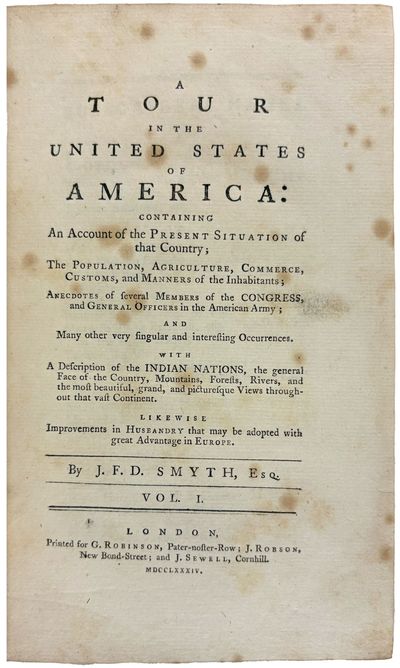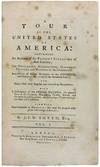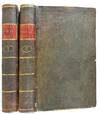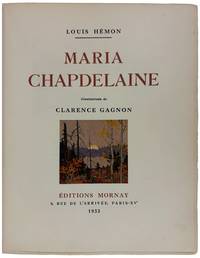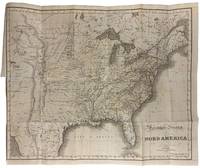Two volumes. Octavo
1784 · London
by SMYTH, John Ferdinand Dalziel (also known as John Ferdinand Smyth STUART) (1745-1814)
London: G. Robinson, J. Robson and J. Sewell, 1784. Two volumes. Octavo. (8 1/4 x 5 inches). Volume I: [x], iv, [10], 400 pp. Volume II: [xii], 455, [1]pp. Half-titles, list of subscribers. Contemporary speckled calf, flat spines ruled in gilt, red morocco lettering-pieces. Housed within a red cloth slipcase
The first edition of an important description of America during the Revolution.
First edition of what Streeter called "the best description of America at the time of the Revolution," issued in 1784, the year Congress ratified the Treaty of Paris (January 14, 1784). Smyth, a Scottish-born army surgeon who practiced medicine at Williamsburg, Virginia before the war, traversed the backcountry from tidewater Virginia through the Carolinas into newly opened Kentucky, descended the Ohio and Mississippi to New Orleans, and returned by way of the Gulf and Atlantic coasts. His pages combine topographical description with pointed remarks on enslavement in the Chesapeake, frontier settlement patterns, Native diplomacy, and the commercial prospects of the trans-Appalachian West. Seized by Patriot forces in New Jersey in 1776, Smyth escaped, spied for the British around New York, and ultimately sailed for England; his account of imprisonment, court-martial, and narrow avoidance of a rebel noose supplies one of the rare published Loyalist perspectives on the middle-Atlantic campaigns. Interspersed are ethnographic sketches of Cherokee, Creek, and Shawnee communities and a defense of British-Indian alliance strategies that foreshadow post-war border tensions.
Streeter Sale II: 827; Howes S-730; Sabin 85254; Clark II:62; Servies 612; Field 1447; Reese, Revolutionary Hundred 79. (Inventory #: 42324)
The first edition of an important description of America during the Revolution.
First edition of what Streeter called "the best description of America at the time of the Revolution," issued in 1784, the year Congress ratified the Treaty of Paris (January 14, 1784). Smyth, a Scottish-born army surgeon who practiced medicine at Williamsburg, Virginia before the war, traversed the backcountry from tidewater Virginia through the Carolinas into newly opened Kentucky, descended the Ohio and Mississippi to New Orleans, and returned by way of the Gulf and Atlantic coasts. His pages combine topographical description with pointed remarks on enslavement in the Chesapeake, frontier settlement patterns, Native diplomacy, and the commercial prospects of the trans-Appalachian West. Seized by Patriot forces in New Jersey in 1776, Smyth escaped, spied for the British around New York, and ultimately sailed for England; his account of imprisonment, court-martial, and narrow avoidance of a rebel noose supplies one of the rare published Loyalist perspectives on the middle-Atlantic campaigns. Interspersed are ethnographic sketches of Cherokee, Creek, and Shawnee communities and a defense of British-Indian alliance strategies that foreshadow post-war border tensions.
Streeter Sale II: 827; Howes S-730; Sabin 85254; Clark II:62; Servies 612; Field 1447; Reese, Revolutionary Hundred 79. (Inventory #: 42324)
